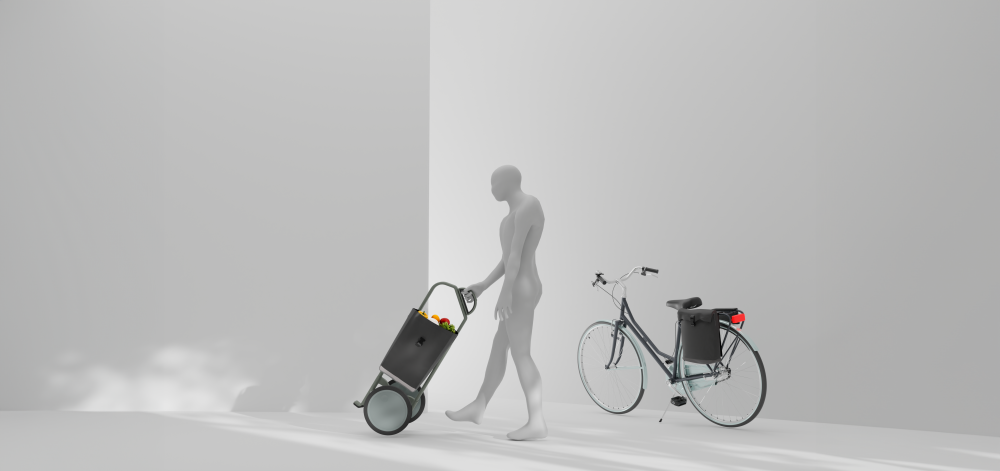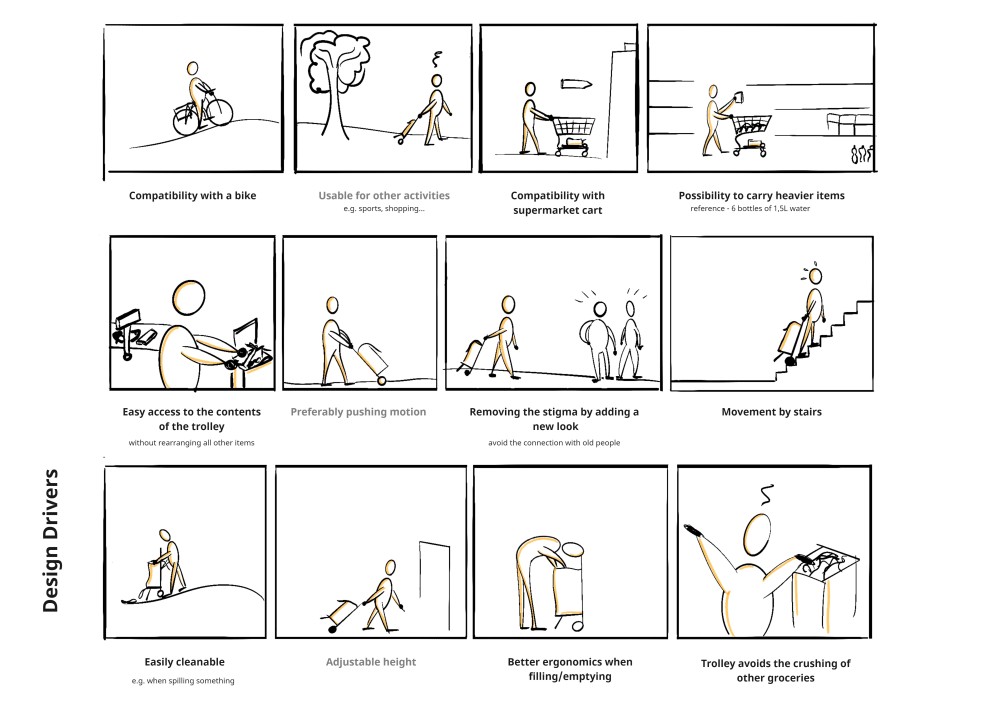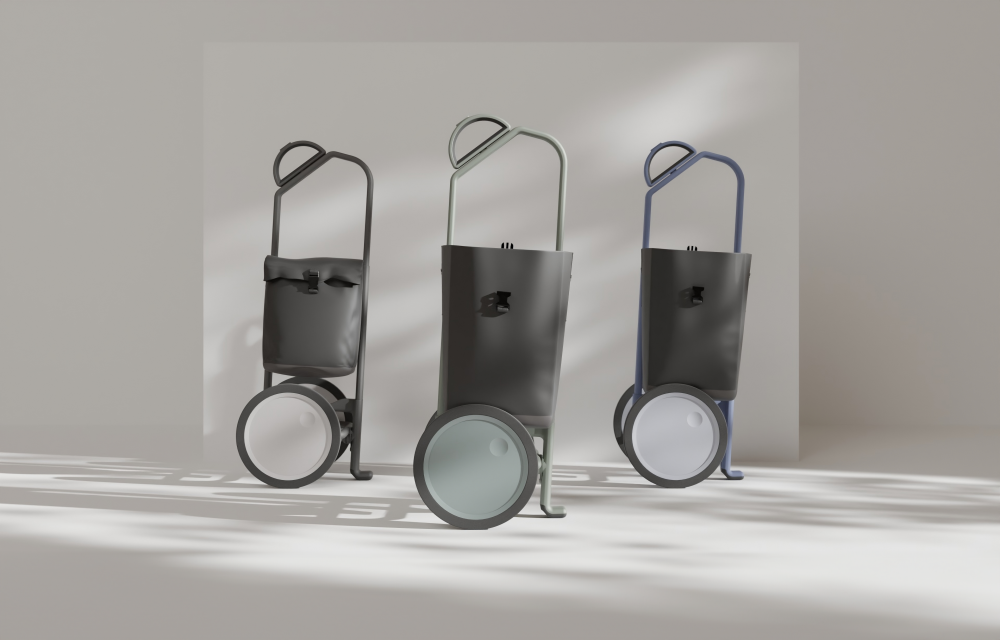De boodschappen trolley heruitvinden: een groene stap vooruit
Het snel veranderende stadsleven heeft een nieuwe uitdaging opgeworpen voor jongvolwassenen: efficiënt boodschappen doen in autovrije stedelijke omgevingen. Een oplossing hiervoor is de boodschappentrolley, maar jammer genoeg hangt daar het clichébeeld van de 65-plusser met z’n kitscherige tas op wieltjes aan vast. De moderne, milieubewuste consument heeft nood aan een toegankelijke, aantrekkelijke oplossing. Dit artikel onthult een modulair ontwerp dat de traditionele boodschappentrolley opnieuw uitvindt en stadsbewoners een groenere en handigere winkelervaring biedt.

Stedelijke mobiliteit en boodschappen doen
In steden over de hele wereld wordt het gebruik van privéauto's in het stadscentrum ontmoedigd of zelfs verboden. Dit heeft geleid tot een groeiende behoefte aan alternatieve vervoersmethoden voor boodschappen. Vooral jongvolwassenen hebben de neiging om dicht bij hun favoriete winkels te wonen, maar het ontbreken van een geschikt vervoermiddel kan een obstakel vormen voor hun dagelijkse boodschappenroutine.
"Ik zou nooit een boodschappentrolley gebruiken doordat dit er zo ouderwets uit ziet."
Uit recent onderzoek blijkt dat steeds meer jongvolwassenen de voorkeur geven aan fietsen als alternatieve vervoerswijze voor boodschappen. Deze trend onderstreept de noodzaak van een betaalbare en milieuvriendelijke oplossing om boodschappen te vervoeren, zonder de hoge kosten van een cargofiets.
Gebruikersgericht ontwerp voor een nieuwe ervaring
Dit project zet de behoeften en voorkeuren van jonge stadsbewoners centraal in het ontwerpproces. Door gebruik te maken van de gebruiksgerichte ontwerptechnieken, met diepgaande interviews en uitgebreide gebruikerstests, is een modulaire trolley ontstaan die zowel geschikt is om te wandelen als om te fietsen. Gebruikerstesten tonen aan dat dit product de winkelervaring in stedelijke omgevingen aanzienlijk kan verbeteren.

Ergonomie en design: het comfort van de toekomst
Een van de belangrijkste focuspunten van dit project was het verbeteren van de ergonomie van de boodschappentrolley. Onderzoek toonde aan dat duwen ergonomisch gezien beter is dan trekken, en dit inzicht heeft geleid tot ontwerpaanpassingen zoals grotere wielen en een enkele gebogen stang, waardoor het comfort en de functionaliteit aanzienlijk zijn verbeterd.
Toekomstige uitdagingen en kansen
Hoewel dit project veelbelovende resultaten heeft opgeleverd, is er nog werk aan de winkel om het ontwerp productierijp te maken. Dit omvat gedetailleerde ontwerpaanpassingen, materiaalselectie en technische finetuning. Verder onderzoek en gebruikerstests zullen bijdragen aan verdere verfijning en aanpassing van het product aan de specifieke behoeften van jonge stadsbewoners.
Dit project toont aan hoe innovatie en design een cruciale rol kunnen spelen bij het oplossen van stedelijke uitdagingen. De heruitgevonden boodschappentrolley vertegenwoordigt een veelbelovende stap naar een groenere en meer gebruikersvriendelijke stadservaring, waarbij duurzaamheid en efficiëntie hand in hand gaan.

Conclusie
Deze baanbrekende heruitvinding van de boodschappentrolley belooft een groene revolutie in stedelijke winkelervaringen. Geïnspireerd door de behoeften van jonge stadsbewoners, biedt de trolley niet alleen een praktische oplossing voor boodschappen doen zonder auto, maar ook een duurzame keuze die de stadslevens van morgen zal vormgeven.
Bibliografie
Le Vine, S., Adamou, O., & Polak, J. (2014). Predicting new forms of activity/mobility patterns enabled by shared-mobility services through a needs-based stated-response method: Case study of grocery shopping. Transport Policy, 32, 60–68. https://doi.org/10.1016/j. tranpol.2013.12.008
Bawa, K. (1999, May 1). A Model of Household Grocery Shopping Behavior. SpringerLink. https://link.springer.com/article/10.1023/A:1008093014534?error=cookies… supported&code=728fc7af-7c7a-4c6e-ac1f-3abc446535ad
Hagberg, J., & Holmberg, U. (2017). Travel modes in grocery shopping. International Journal of Retail &Amp; Distribution Management, 45(9), 991–1010. https://doi.org/10.1108/ ijrdm-08-2016-0134
Nieuwenhuijsen, M. J., & Khreis, H. (2016). Car free cities: Pathway to healthy urban living. Environment International, 94, 251–262. https://doi.org/10.1016/j.envint.2016.05.032 Carrone, A., & Rich, J. (2020). A micro-model of car ownership dynamics: are preferences changing?. Transportation Letters.
Dautzenberg, P. S. C., Voß, G. M., I., Wang, L., Reske, M., Brockmeier, C., & Ladwig, S. (2021). User-Oriented Transport Solutions: An Ergonomic Investigation of Two Novel Concepts. SpringerLink. https://link.springer.com/chapter/10.1007/978-3-030-80012- 3_47?error=cookies_not_supported&code=9ff0d9e4-029f-4404-8cda-cb9382f609b1
Cycling Industries Europe. (2021, May 26). Growth and trends of cargo bike sales in Europe CIE. https://cyclingindustries.com/news/details/growth-and-trends-of-cargo-b…- in-europe-we-need-your-input
Meerstra. (2021). Perceived safety of cargo bikes: A barrier against a “greener future”? - Student Theses Faculty Spatial Sciences. https://frw.studenttheses.ub.rug.nl/3547/
Heinrich, L., Schulz, W. A., & Geis, I. (2016). The Impact of Product Failure on Innovation Diffusion: The Example of the Cargo Bike as Alternative Vehicle for Urban Transport. Transportation Research Procedia, 19, 269–271. https://doi.org/10.1016/j. trpro.2016.12.086
Laakso, S. (2017). Giving up cars – The impact of a mobility experiment on carbon emissions and everyday routines. Journal of Cleaner Production, 169, 135–142. https://doi. org/10.1016/j.jclepro.2017.03.035
Hinchliffe, J. (2018, July 21). Overloaded reusable bags causing shoppers injuries, leaving physios to shoulder the burden. ABC News. https://www.abc.net.au/news/2018-07-22/ overloaded-reusable-bags-causing-injuries-for-shoppers/10017294
Trudelle-Jackson, E., Ferro, E., & Morrow, J. (2011). Clinical Implications for Muscle Strength Differences in Women of Different Age and Racial Groups: The WIN Study. Journal of Women’s Health Physical Therapy.
LEE, I. M., & BUCHNER, D. M. (2008). The Importance of Walking to Public Health. Medicine &Amp; Science in Sports &Amp; Exercise, 40(7), S512–S518. https://doi.org/10.1249/ mss.0b013e31817c65d0
Li, B., Liu, J., Yu, B., & Zheng, X. (2022). The Environmental Impact of Plastic Grocery Bags and Their Alternatives. IOP Conference Series: Earth and Environmental Science, 1011(1), 012050. https://doi.org/10.1088/1755-1315/1011/1/012050
Brembeck, H., Hansson N., & Vayre, J. (2016). Life Phases, Mobility and Consumption: An Ethnography of Shopping Routes. Routledge.
Kwong, E. (2010). Views of Adults on Shopping Trolleys: Implications for the Development of a Shopping Trolley~!2010-01-14~!2010-05-27~!2010-07-20~! The Ergonomics Open Journal, 3(1), 32–37. https://doi.org/10.2174/1875934301003010032
Li, X., Jervis, S., & Drake, M. (2015). Examining Extrinsic Factors that Influence Product Acceptance: A Review. Journal of Food Science, 80(5), R901–R909. https://doi. org/10.1111/1750-3841.12852
Desmet, P. M. A., Porcelijn, R., & van Dijk, M. B. (2007). Emotional Design; Application of a Research-Based Design Approach. Knowledge, Technology &Amp; Policy, 20(3). https:// doi.org/10.1007/s12130-007-9018-4
Walker, D. H. T., Bourne, L. M., & Shelley, A. (2008). Influence, stakeholder mapping and visualization. Construction Management and Economics, 26(6), 645–658. https://doi. org/10.1080/01446190701882390
Murray-Webster, R., & Simon, P. (2006). Making Sense of Stakeholder Mapping. PM World Today, 8(11). https://skat.ihmc.us/rid=1JGD4CJZ4-F9CF0Y-1KM6/SEMINAL%20 stakeholder%20mapping%20in%203d.pdf
Maya Goodwill (in collaboration with Kennisland) (2020). A Social Designer’s Field Guide to Power Literacy. https://www.powerliteracyfieldguide.com/
Balcaitis, R. (2022). Design Thinking models. Stanford d.school. Empathize IT. https:// empathizeit.com/design-thinking-models-stanford-d-school/
Wolniak, R. (2017). The Design Thinking method and its stages. Systems Supporting Production Engineering, 247–255. http://yadda.icm.edu.pl/yadda/element/bwmeta1.element. baztech-81d700a1-e4ea-4257-87cf-d0b790873bc8/c/wolniak2_SWwIP_2017_6.pdf
Abras, C., Maloney-Krichmar, D., Preece, J. (2004) User-Centered Design. In Bainbridge, W. Encyclopedia of Human-Computer Interaction. Thousand Oaks: Sage Publications Ulrich, K., & Eppinger, S. (2019). Product Design and Development (7th ed.). McGraw-Hill Education.
Rose, J., Mendel, E., & Marras, W. S. (2013). Carrying and spine loading. Ergonomics, 56(11), 1722–1732. https://doi.org/10.1080/00140139.2013.835870
Chitena, D., Ude, A. U., Chinnasamy, V., & Zeundjua, T. (2022). A review on the usability of wheeled luggage. Cogent engineering, 9(1). https://doi.org/10.1080/23311916.2022.21 43038
Jung, M., Haight, J. M., & Freivalds, A. (2005). Pushing and pulling carts and two-wheeled hand trucks. International Journal of Industrial Ergonomics, 35(1), 79–89. https://doi. org/10.1016/j.ergon.2004.08.006
Jung, M.-C. (2004). Ergonomic assessment of a wheeled luggage pulling task - ProQuest. https://www.proquest.com/openview/94621ddf447a3ab63b7a5c610f793c85/1?pq- origsite=gscholar&cbl=18750&diss=y
Lee, J.-S. (2006). Design assessment of two-wheeled luggage based on mechanical models and a usability test - ProQuest. https://www.proquest.com/openview/17d7584b06f6964 2232a5702f9a64000/1?pq-origsite=gscholar&cbl=18750&diss=y
Jung, M., Haight, J. M., & Freivalds, A. (2003). Kinematic Evaluation of Pulling Carry-on Luggage. Proceedings of the Human Factors and Ergonomics Society Annual Meeting, 47(10), 1290–1294. https://doi.org/10.1177/154193120304701041
Farivar, S., & Naeini, H. S. (2012). A survey of ergonomic parameters of shoppers. The International Association for Automation and Robotics in Construction. https://www.iaarc. org/publications/fulltext/A_survey_of_ergonomic_parameters_of_shoppers.pdf
Gutchess, A. H., Kensinger, E. A., & Schacter, D. L. (2010). Functional neuroimaging of self-referential encoding with age. Neuropsychologia, 48(1), 211–219. https://doi. org/10.1016/j.neuropsychologia.2009.09.006
Suri, J. F., & Marsh, M. L. (2000). Scenario building as an ergonomics method in consumer product design. Applied Ergonomics, 31(2), 151–157. https://doi.org/10.1016/s0003- 6870(99)00035-6
Kuehnl, C., Jozic, D., & Homburg, C. (2019). Effective customer journey design: consumers’ conception, measurement, and consequences. Journal of the Academy of Marketing Science, 47(3), 551–568. https://doi.org/10.1007/s11747-018-00625-7
Nixon, S. (2013). Binderchart. https://deepblue.lib.umich.edu/bitstream/ handle/2027.42/108421/smnixo_1366940592.pdf;sequence=1
RODRIGUEZ, V., & ANTONIO, P. (2015, October 1). Accessory for urban bicycles to transport fresh products after grocery shopping. https://www.politesi.polimi.it/ handle/10589/112695
Kostecka, A. (2012). Master’s degree project at Academy of Fine Arts. Behance. https:// www.behance.net/gallery/3517729/Shopping-trolley-design
Giesta, S. (2017). Shoppingmate. Behance. https://www.behance.net/gallery/54529781/ SHOPPINGMATE-2017?tracking_source=search_projects%7Cshopping+trolley
Samson, Y. (2018). EEVO shopping trolley Eastpack. Behance. https://www.behance. net/gallery/106844235/FR-EEVO-Product-design-Shopping-trolley-Eastpak?tracking_ source=search_projects%7Cshopping+trolley
Choi, D. (2021). This trash-collecting design is a hand-operated multifunctional trolley that helps sort your recycling! Yanko Design - Modern Industrial Design News. https:// www.yankodesign.com/2021/12/06/this-trash-collecting-design-is-a-hand-o…- multifunctional-trolley-that-helps-sort-your-recycling/
Pinto, M., & Ximenes, F. (2012). Lévo - Shop Til You Drop. Yanko Design - Modern Industrial Design News. https://www.yankodesign.com/2012/10/03/shop-til-you-drop/
Delahaie, R. (2019). Jumble. Behance. https://www.behance.net/gallery/79252299/- Shopping-Trolley?tracking_source=search_projects%7Cshopping+trolley
Miaskiewicz, T., & Kozar, K. A. (2011). Personas and user-centered design: How can personas benefit product design processes? Design Studies, 32(5), 417–430. https://doi. org/10.1016/j.destud.2011.03.003
Driver, A. (2018, March 26). Design Drivers: What drives great design? Team Consulting. https://www.team-consulting.com/insights/design-drivers-what-drives-gre… Milton, A., & Rodgers, P. (2013). Research Methods for Product Design.
Herbruikbare plastic zak (LDPE) minst schadelijk voor de planeet. (2021, August 25). Testaankoop. https://www.test-aankoop.be/woning-energie/milieu/nieuws/milieu- impact-boodschappentassen
Ceschin, F., & Gaziulusoy, İ. (2019). Design for Sustainability (Open Access): A Multi-level Framework from Products to Socio-technical Systems. Routledge.









